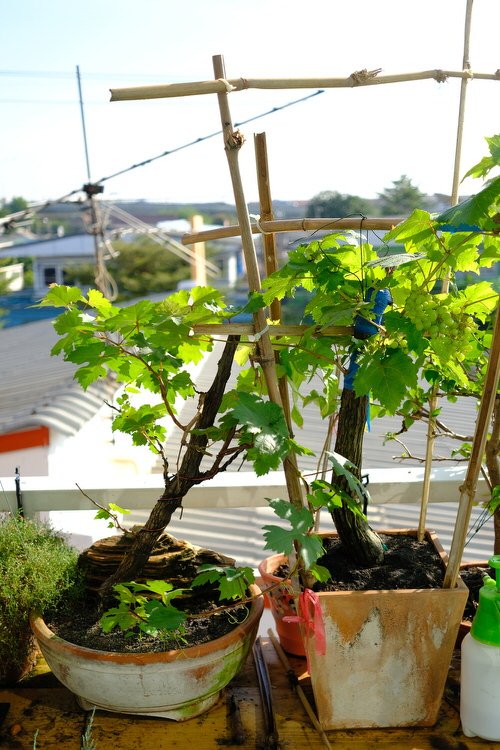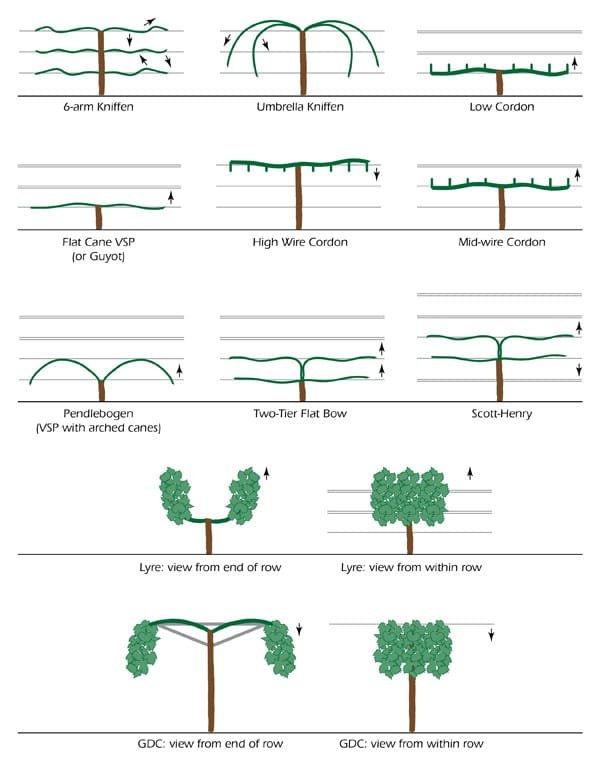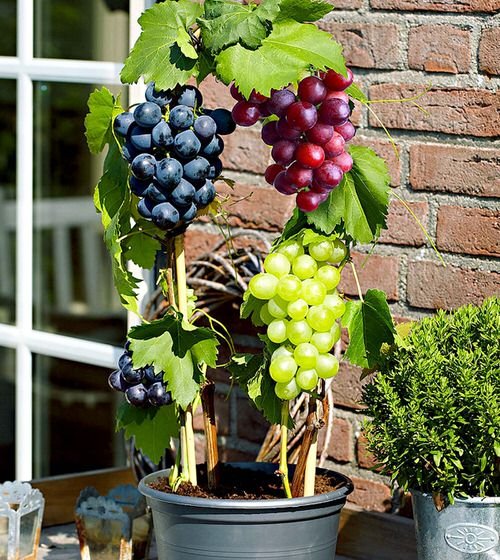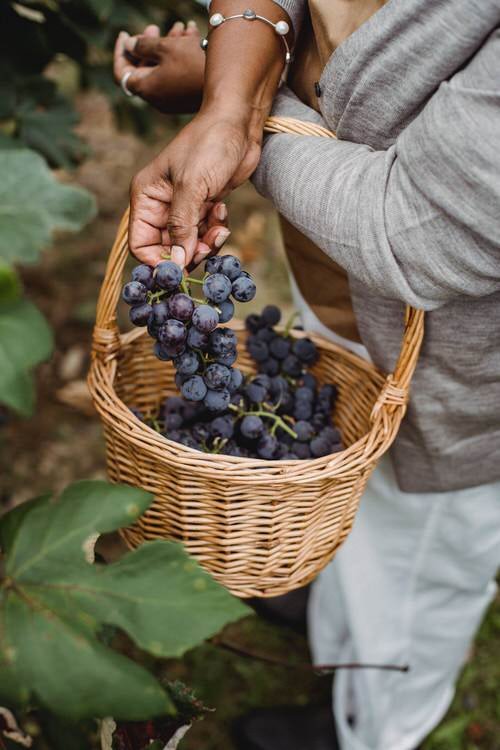Learn How to Grow Grapes in Pots in easy steps. It is not very complicated and requires just slight care and maintenance. Check out below!
Growing Grapes in Containers is the best way to enjoy the fresh bunch of its fruits in a short space like a balcony or a patio. What’s more, you can also make vine from the organic harvest! Let’s have a look at How to Grow Grapes in Pots.
Check out some useful grape vine trellis ideas here
Choosing a Pot
For growing grapes in containers, choose a large and sturdy container that can support this vigorous vine. A 15-20 gallon pot that is at least 16-18 inches deep and 18-24 inches wide is sufficient. Start with a smaller-sized pot and then repot the plant in a larger one.
Best Varieties of Grapes for Containers
The best option is to go to a garden center and ask for a variety that can grow well in pots and in your climate. There are many varieties of grapevine you can choose from.
Choosing a variety that is resistant to diseases and can grow well in your zone is essential. However, you can grow almost any variety in the container but growing a dwarf grape cultivar like ‘pixie’ can save you from the hassle of training a grapevine in a pot.
Here’s all you need to know about growing Apple in pots
Planting Grapes in Containers
The best time to plant grapevine is spring or early summer; planting at this time helps the plant to grow all season without the exposure to frost. But if you live in a frost-free hot tropical climate, the best time for planting grape vines is winters.
Supporting and Training Grapes

Grapevine needs training and support to grow. When growing grapes in a pot, it is best to opt for a tall lightweight trellis of wood or plastic. You can also DIY a trellis for it.
A grapevine grows long and requires support; it will be much better if you have an arbor or pergola-like structure. Train the vine on a stake or something like a fan trellis. You can also support the vine on a stake with the help of the “Umbrella Kniffen Training Method.”
To learn more about this method, read this helpful article on pallensmith.com. Growing grapes in pots by the standard vine training method on a regular trellis is also easy and hassle-free.
Check out our article on how to grow pineapple in pots here
Requirements for Growing Grapes in Pots
Location / Position
Choose a location that is sunny, warm, and dry. If your spot receives shade in the afternoon, the plant will still do well, but at least 5-6 hours of sunlight is required.
Avoid keeping the plant in a wet, shady, and less windy spot with no air circulation as it promotes fungal diseases, and the grapevine requires good air circulation around it.
Soil
Don’t use heavy garden soil when growing grapes in containers. Instead, use a light potting mix that is loose, rich in organic matter, and most importantly, drains well.
Watering
Water regularly and deeply to keep the soil slightly moist but avoid overwatering. Soggy, damp soil can be detrimental to the plant.
Fertilization
Side dress the plant periodically with aged manure or compost. In the first year, you can fertilize the plant with a general-purpose fertilizer in spring and summer.
From the next year, start to fertilize the plant with a fertilizer that is low in nitrogen but high in potassium and phosphorus from the spring when flower buds appear.
Here are the best berries to grow in pots
Growing Grapes in Tropics
Grapes are actually temperate fruits, but the best thing about them is they can be grown in both temperate and tropical regions. Temperate climate zones without very harsh summers or humidity are optimum for growing grapevines.
The two tropical countries, India and Brazil, are one of the largest producers of grapes in the world. Other tropical countries like Yemen, Thailand, Peru, and Tanzania also produce grapes but to a smaller extent. This means if you live in a tropical climate, you can still grow grapevines. You’ll only need to find the right variety that grows successfully in your area.
Still, in the tropics, areas with very high humidity or with heavy rainfall are less suitable for growing grapevine, and if you’re living in an unfavorable climate like this, your plant will going to suffer from fungal diseases regularly, and you’ll have to look after it more. Besides this, there is a possibility that the fruits you’ll obtain will be of lesser quality.
Learn all about growing tamarind in pots here
Grape Vine Care in Pots
Pollination
When growing grapes in containers, you must know most grape varieties are self-fertile and produce fruits on their own. However, shaking the plant gently at the time of flowering results in a better yield.
Mulching
Grapevine requires mulching when grown on the ground. You can also mulch in the pot with pine bark, compost, or with pebbles (this way, it will look great too) to prevent excessive water evaporation from the soil and to protect roots from temperature fluctuations.
Overwintering
In climates with harsh winters, you have to protect the plant. For this, you’ll need to remove the dormant grapevine from its support and start to keep it indoors in a warm space. Also, reduce watering and avoid the application of any fertilizer during this period.
Diseases and Pests
In diseases, fungal diseases like black spots and powdery mildew, especially in dry and warm weather are possible. In pests, keep an eye on common garden insects like aphids. Japanese beetles, moths, and caterpillars can also be a problem.
Pruning Grapes
During the first few months after planting until the end of the growing season, do not prune the plant and allow it to grow freely to let the plant establish well in a pot and allow it to develop a strong root system.
Prune the growth in late winter to early spring during the dormancy so that only two buds will remain. Buds are small protrusions on the trunk. This heavy pruning may seem too much to do, but in the spring and summer, each of these buds will grow into a new branch.
Dedicate the first year to training the vine to follow your trellis or stack with pruning and tying. Due to the limited space of the container, try to keep only 1 or 2 branches growing from the main trunk. Also, prune away any runners that creep away from the trellis.
The most important pruning will be one that you will perform in late winter when the plant sheds its leaves, it is the one on which the fruiting depends. You will need to do the summer pruning too. Though it should have to be light and unobtrusive, just pinching and pruning.
Note: Grapevine woods that are more than two years old do not produce fruits, so you’ll have to remove all the old branches.
Harvesting Grapes
Harvesting should be done when your grape plant is at least 2-3 years old. Generally, grapes ripen anytime between late August to late October. Exactly when it depends on the variety and the type of climate you’re growing them in.
To find out whether your grapes are ready for harvesting or not is to taste them. If they taste sweet and nice, pick them. If they don’t, then leave them for a few more days.
Once the grapes start to change their color, they usually take anywhere between 1 to 3 weeks to become properly ripe (how long depends on the variety and how good the climate is.
For example, green grapes normally turn slightly translucent, and their skins become yellow once they are ripe. Eventually, the taste is all that matters. If you like the taste, then pick them.










Nice information thanks. Like to learn more about organic vegetable gardening please post some more information in my fbmsg or on my email.
Love the way to garden on patio sure do need some help win pots and soil, thanks, connie
A 6-month old grapevine growing in a 60-liter pot has roots on the surface. I covered it with about two inches of soil and put dried tamarind leaves on top as mulch. After about a month, I noticed that the grapevine has stopped growing. When I checked on the soil and removed the mulch, I saw the roots on the surface again. What could be the problem? (I water this grapevine once a week with about 6 liters of water each time)
Maybe the soil is too heavy for them. I have, however, seen some vines having roots on the surface for a few inches before going in the ground, but they were planted in the garden, not in pots.
Agreed. The soil may be too heavy (use potting soil) or you may be overwatering in which case the deep root zone is unacceptable.
Maybe it’s just me, but when I click the link to see how to grow grapes in a tree form the actual article is about how to start a church…
It isn’t just you! I was very confused when the same thing happened to me
Hey, thank you for pointing it out. There seems to be a problem with the third party website. We’ve updated the article with the new link.
Any recommendation on name for fertilizer?
My vine has gone crazy in its first year and as suggested I have trained it but not cut anything. I need to transfer to a larger container and wondered when would be the best time of year to do this. It currently spans 4’ and the new shoots are 3’ from the pot surface so I’m guessing it’s got a good root system. I would like to produce a 4 or 6 arm kniffen.
The soil needed for grapes should be slightly acidic to neutral. Never dig up the dirt in your garden or backyard to fill pots; that soil could contain bacteria.
Grapes typically don’t grow in containers, so the right pot is vital. You should pick a large, sturdy container that can support the vines that grow vigorously and large.
Nice article. Thanks. Quick question. The soil in my grape pots has shrunk down. Is it okay to backfill or add more soil to the pots? It’s summer here and they’re drying out faster than they used to. Thanks in advance.
Never mind. I just added mulch and they were fine. I transplanted them into bigger pots with more sandy soil and they’re just breaking bud now.